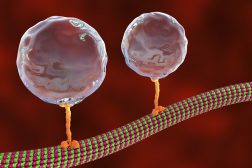Definition
noun
(cytogenetics) A selective banding technique wherein a banding pattern is produced in the constitutive heterochromatin located at the centromeres of chromosomes and on the distal long arm of the Y chromosome
Supplement
Different staining techniques are employed in order to visualize the chromosomes of a cell. Cytogeneticists use banding techniques to determine the characteristic pattern of light and dark bands on a chromosome under a microscope. They make use of diagrams referred to as chromosome ideograms to determine the relative sizes and the banding patterns of chromosomes. By applying specific stains, the banding patterns become apparent. The different types of banding are Giemsa (G-) banding, reverse (R-) banding, constitutive heterochromatin (C-) banding, quinacrine (Q-) banding, Nucleolar Organizer Region (NOR-) banding, and telomeric R (T-) banding.
C-banding is a cytogenetic banding technique that employs Giemsa stain that binds to constitutive heterochromatin. The domains of constitutive heterochromatin are the regions of DNA in the chromosomes of eukaryotes. Most of them are found at the pericentromeric regions of the chromosomes. (Few are found at the telomeres or other parts of the chromosome)1 This technique produces a banding pattern in the heterochromatin of the centromeric regions.
C-banding staining method is done by applying Giemsa stain after most of the DNA is denatured or extracted by treatment with alkali, acid, salt, or heat. In human chromosomes, this technique will stain only heterochromatic regions close to the centromeres and rich in satellite DNA stain, with the exception of the Y chromosome whose long arm usually stains throughout.
Abbreviation / Acronym:
- C-banding
See also:
Reference(s):
1 Saksouk, N., Simboeck, E., & Déjardin, J. (2015-01-15). “Constitutive heterochromatin formation and transcription in mammals”. Epigenetics & Chromatin 8.







